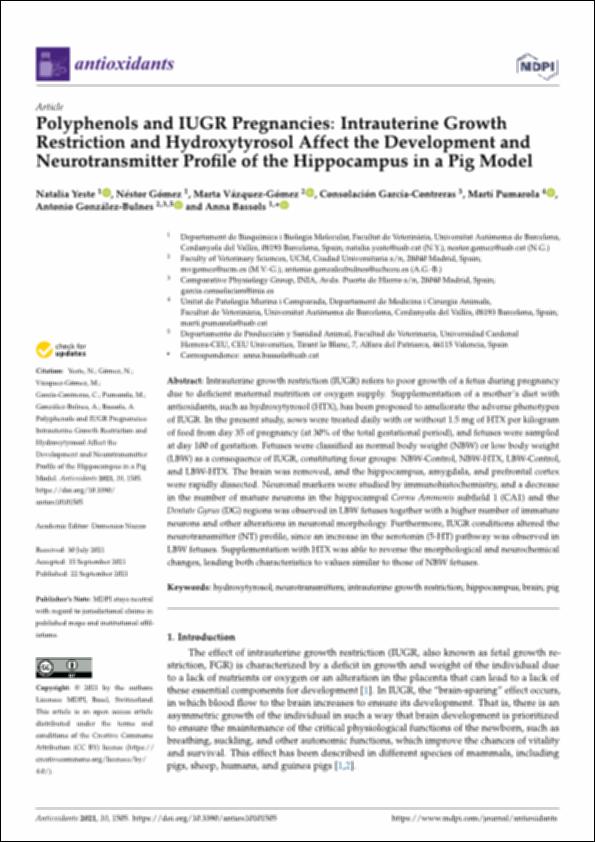Please use this identifier to cite or link to this item:
http://hdl.handle.net/10637/13558Polyphenols and IUGR pregnancies : intrauterine growth restriction and hydroxytyrosol affect the development and neurotransmitter profile of the hippocampus in a pig model
| Title: | Polyphenols and IUGR pregnancies : intrauterine growth restriction and hydroxytyrosol affect the development and neurotransmitter profile of the hippocampus in a pig model |
| Authors : | Yeste Vizcaino, Natalia Gómez Trias, Néstor Vázquez Gómez, Marta García Contreras, Consolación Pumarola i Batlle, Martí González de Bulnes López, Antonio Bassols Teixidó, Anna |
| Keywords: | Hippocampus (Brain) - Effects of chemicals on.; Neurotransmisores.; Neurotransmitters.; Alimentos - Aditivos.; Swine - Neurology.; Hidroxitirosol - Efectos fisiológicos en los animales.; Hydroxytyrosol - Physiological effect.; Hipocampo (Cerebro) - Efectos de los productos químicos.; Cerdos - Neurología.; Food additives. |
| Publisher: | MDPI |
| Citation: | Yeste, N., Gómez, N., Vázquez-Gómez, M., García-Contreras, C., Pumarola, M., González-Bulnes, A. & Bassols, A. (2021). Polyphenols and IUGR pregnancies: intrauterine growth restriction and Hydroxytyrosol affect the development and neurotransmitter profile of the hippocampus in a pig model. Antioxidants, vol. 10, i. 10 (22 sep.), art. 1505. DOI: https://doi.org/10.3390/antiox10101505 |
| Abstract: | Intrauterine growth restriction (IUGR) refers to poor growth of a fetus during pregnancy due to deficient maternal nutrition or oxygen supply. Supplementation of a mother’s diet with antioxidants, such as hydroxytyrosol (HTX), has been proposed to ameliorate the adverse phenotypes of IUGR. In the present study, sows were treated daily with or without 1.5 mg of HTX per kilogram of feed from day 35 of pregnancy (at 30% of the total gestational period), and fetuses were sampled at day 100 of gestation. Fetuses were classified as normal body weight (NBW) or low body weight (LBW) as a consequence of IUGR, constituting four groups: NBW-Control, NBW-HTX, LBW-Control, and LBW-HTX. The brain was removed, and the hippocampus, amygdala, and prefrontal cortex were rapidly dissected. Neuronal markers were studied by immunohistochemistry, and a decrease in the number of mature neurons in the hippocampal Cornu Ammonis subfield 1 (CA1) and the Dentate Gyrus (DG) regions was observed in LBW fetuses together with a higher number of immature neurons and other alterations in neuronal morphology. Furthermore, IUGR conditions altered the neurotransmitter (NT) profile, since an increase in the serotonin (5-HT) pathway was observed in LBW fetuses. Supplementation with HTX was able to reverse the morphological and neurochemical changes, leading both characteristics to values similar to those of NBW fetuses. |
| Description: | Este artículo se encuentra disponible en la siguiente URL: https://www.mdpi.com/2076-3921/10/10/1505 Este artículo pertenece al número especial "Natural or Synthetic Antioxidants for Neurodegenerative Diseases and Brain Health". |
| URI: | http://hdl.handle.net/10637/13558 |
| Rights : | http://creativecommons.org/licenses/by/4.0/deed.es |
| ISSN: | 2076-3921 (Electrónico) |
| Issue Date: | 22-Sep-2021 |
| Center : | Universidad Cardenal Herrera-CEU |
| Appears in Collections: | Dpto. Producción y Sanidad Animal, Salud Pública Veterinaria y Ciencia y Tecnología de los Alimentos |
Items in DSpace are protected by copyright, with all rights reserved, unless otherwise indicated.


